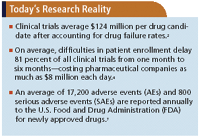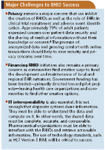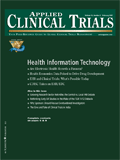Electronic Health Records: A Magic Pill?
EHR has the potential to help solve long-time clinical trial recruitment, cost, and safety challenges.
In 2004, President Bush presented a formidable challenge to the health care industry when he called for widespread adoption of electronic health records (EHRs) in the United States and the creation of a National Health Information Network (NHIN) by 2014. Since that time, health care organizations, community health professionals, and technology vendors have turned their attention to creating the strategies, protocols, and IT infrastructures necessary to make this vision a reality. As part of this effort, a growing number of health care organizations are choosing to participate in regional health information organizations (RHIOs), umbrella organizations for local data exchange networks and gateways, which many view as an essential element in the formation of a NHIN.

In recent years, we have also seen increased documentation regarding the potential for electronic health record networks to improve continuity of patient care, reduce medical errors, and lower health care costs. Adoption of electronic medical records (EMRs) in both hospitals and private practice is rising steadily, with 50% of U.S. hospitals using electronic medical/health record systems.1
As exciting, but often less reported, are the potential benefits that electronic health records—aggregated through RHIOs and, ultimately, the NHIN—can deliver to the life sciences industry. There are significant crossover benefits that take aim at three of the industry's most vexing challenges: more effective and efficient identification and recruitment of clinical trial participants, the ability to simultaneously capture clinical trial data from the electronic health record to decrease the costs of clinical trials, and faster identification of adverse events postmarket.
Faster and cost-effective recruitment
With the cost of developing a new prescription drug creeping toward $1 billion and the process often spanning more than a decade, pharmaceutical manufacturers are continually searching for ways to extend efficiencies at all stages of the development continuum, allowing them to bring safe products to market faster and at a lower cost.
Clinical trials—which average $124 million per drug candidate after accounting for drug failure rates2 and whose costs are rising faster than preclinical research and development activities—are a prime target for scrutiny. Rising clinical trial costs can be attributed to several factors, including new challenges related to trial candidate identification and recruitment. The number of patients required for a trial by U.S. drug regulators, for instance, has almost doubled in the past decade.

Todays Research Reality
Clinical trial patient recruitment is also an increasingly time-consuming process. One study, which looked at 4000 clinical trials over five years, discovered that nearly half of the time spent on the trial process involved patient, site, and investigator recruitment.3 On average, difficulties in patient enrollment delay 81% of all clinical trials from one to six months, costing pharmaceutical companies as much as $8 million each day.4 This figure does not take into account the human costs of such delays in terms of the inevitable morbidity and mortality when promising new drugs are delayed in reaching the market.
Connecting RHIOs and clinical trials
RHIOs and the patient information they collect are poised to play an important role in the pharmaceutical industry's quest to bring products to market faster, more cost effectively, and at a lower risk. Specifically, RHIOs, which have the potential to aggregate large amounts of anonymized patient information, offer an ideal tool for cost-effective identification and recruitment of clinical trial participants.
In theory, life sciences organizations or contract research organizations (CROs) could interface with multiple RHIOs, and ultimately the NHIN, to quickly screen large numbers of anonymized electronic records for potential trial candidates using any number of factors, including age, sex, co-morbidities, lab results, etc. In this way, they could approach physician groups that they know treat significant numbers of patients matching a specific trial candidate profile. This method could be particularly useful when recruiting for trials for drugs intended to treat rare conditions, as the sponsor could search for specific criteria. The end result could be faster and more cost-effective trial participant identification and recruitment, ultimately accelerating time to market.
While the approach outlined above would enable more effective targeting of physician practices that treat viable candidates, another approach being advanced would take information on clinical trials directly to potential candidates. It would involve the creation of a patient opt-in mechanism, in which individuals would grant permission to have life sciences organizations access their health information when launching a clinical trial and contact them directly. This approach could go a long way toward empowering patients to take charge of key health decisions, as well as streamline the participant recruitment process.

Major Challenges to RHIO Success
To optimize the success of this approach, physicians would also need to be notified, in tandem, when a trial sponsor contacts their patients. Studies indicate that patients are most likely to participate in trials when information is provided in a health care setting, as opposed to delivered via advertising and direct mail.
To gain access to RHIO or NHIN information, life sciences organizations would pay a transaction or subscription fee, which would be more than offset by the savings gained via faster and more effective recruitment. This revenue would also be an important factor in ensuring the self-sufficiency of RHIOs, which is required for their ultimate success.
Value of data on a smaller scale
Today, initiatives at individual investigator sites are revealing glimpses into the potential of EHR data to transform clinical trial recruitment. For example, researchers from the University of Cincinnati College of Medicine studied the potential of a clinical trial alert (CTA) system to increase physician participation in and expedite recruitment of patients for a clinical trial. After one year of traditional recruitment to a clinical trial, the researchers used their EHR-based CTA system at The Cleveland Clinic to recruit patients. When a patient's records met selected trial criteria, the CTA alerted the physician about the ongoing trial.5
The study revealed that the group using CTA intervention experienced a 10-fold increase in the number of referrals generated by physicians: 5.7 per month before intervention to 59.5 per month after. In addition, the researchers found that the CTA-enabled group recruited more than twice as many trial participants per month (6 participants) than the group using traditional recruitment methods (2.9 participants).5
By combining EHRs with data mining tools and CTA systems, investigator sites have the potential to quickly query the EHR database to determine the number of potential candidates for a specific study and to assess the viability of candidates for a specific trial. For example, during a routine exam, a physician could open a patient's EHR and reference the information documented in it to determine if the patient meets eligibility requirement for a particular clinical trial based on the record and the trial requirements as presented through the CTA. The physician could then either select or dismiss a candidate. If a patient matches the criteria for any study, the physician could immediately collect the additional information required for the trial, record the data in the EHR, and send an electronic notification to a study coordinator for follow-up. At that point, screening for the trial is complete, and within a matter of minutes.
Once a patient is enrolled in a trial, researchers could then incorporate data captured from a specific study as part of routine clinical care and automatically populate study data elements into case report forms (CRFs) from other components of the EHR database. By implementing rules and alert features and documentation checks, organizations are also able to ensure data collection compliance and accuracy.6 Automating these core processes can help accelerate clinical trials by streamlining patient enrollment as well as documentation.

The EHR and RHIO Connection
Accelerating identification of adverse events
An average of 17,200 adverse events (AEs) and 800 serious adverse events (SAEs) are reported annually to the U.S. Food and Drug Administration (FDA) for newly approved drugs.7 Rapid identification and reporting of AEs to the FDA are important for several reasons. First and foremost, they minimize risk to public health. They also reduce corporate legal and reputational risk. As important, diligent reporting by the pharmaceutical industry—in essence, self-policing—is the best defense against the potential of additional regulation or more protracted drug approval processes.
Pharmaceutical manufacturers recognize the benefits of improving their ability to more rapidly identify and interpret AEs. One has only to look to high-profile drug recalls in recent years to get a sense of the potential financial cost. For example, the FDA recalled the drug Fen-Phen in 1998 after reports of heart valve disease and pulmonary hypertension primarily in women who had taken this drug. In April 2005, American Lawyer magazine reported that more than 50,000 product liability lawsuits had been filed in relation to this recall and that the total cost to the manufacturer at the time of publication was estimated to be as high as $14 billion.
Anonymized patient data provided through RHIOs holds the potential to help life sciences organizations in their efforts to more rapidly identify AEs postmarket—protecting public health and reducing corporate risk. In theory, pharmaceutical companies could interface with RHIOs and mine data from anonymized records of patients taking a new drug, with the goal of quickly identifying patterns and reporting adverse reactions that might result from drug and disease interactions or combined drug reactions.
To effectively and quickly identify potential AEs from large numbers of patient records, pharmaceutical organizations require powerful data mining and analytical tools that enable them to track and integrate events from multiple sources, including the Internet, patients, physicians, and regulatory agencies such as the FDA and the World Health Organization. In essence, they require a powerful lens that allows them to rapidly analyze patterns in AEs that may indicate emerging drug safety risks pre- and postmarket, enabling faster response times and streamlined compliance.
As important, organizations require signal detection capabilities to focus on the cases of most interest. Ideally, drug safety teams should have the ability to establish thresholds for automatic safety signal detection, receive alerts when thresholds are reached or exceeded, and assess their case information using data mining tools for statistical analysis.
Forging ahead
RHIOs and the NHIN hold the potential to provide considerable benefits to pharmaceutical organizations, including improving the effectiveness and efficiency of clinical trial recruitment, accelerating the collection of trial information, and identifying AEs. The ability to execute on this vision will require a robust and stable network of RHIOs. Progress on this front is visible but challenges remain.
The health care and life sciences industries are optimistic about the potential of electronic health data to transform the delivery of health care as well as the drug development process, including spurring advances in the quest for personalized and translational treatments and therapies. The critical technology components needed to enable meaningful exchange of information between the health care and life sciences industry exist today—as do the data mining and analytical tools needed to interpret data and drive incisive action. By combining these core technologies with proper planning and vision, RHIOs and other EHRs offer one of the brightest hopes for the future of the health care and life sciences industries and their quest to save and enhance the quality of lives.
Mychelle Mowry is vice president of Global Health Industries with Oracle, 500 Oracle Parkway, Redwood Shores, CA 94065, www.oracle.com. Dennis Constantinou* is senior director of Life Sciences Industry Strategy and Marketing with Oracle, email: dennis.constantinou@oracle.com
*To whom all correspondence should be addressed.
References
1. D. Garets and M. Davis, Electronic Medical Records vs. Electronic Health Records: Yes, There is a Difference, HIMSS Analytics, LLC, January 26, 2006.
2. J.A. Di Masi, R.W. Hansen, H.G. Grabowski, "The Price of Innovation: New Estimates of Drug Development Costs," Journal of Health Economics, 22, 2003.
3. CMR International R&D Briefing: Benchmarking for Efficient Drug Development (2000).
4. CenterWatch, www.centerwatch.com.
5. P.J. Embi, A. Jain, J. Clark, S. Bizjack, R. Hornung, C.M. Harris, "Effect of a Clinical Trial Alert System on Physician Participation in Trial Recruitment," Archives of Internal Medicine, Oct. 24, 2005.
6. National Center for Research Resources: Ensuring the Inclusion of Clinical Research in the National Health Information Network, Integrating Electronic Health Records and Clinical Trials: An Examination of Pragmatic Issues, May 9, 2006. Available at http://www.esi-bethesda.com/ncrrworkshops/clinicalResearch/pdf/MichaelKahnPaper.pdf.
7. U.S. Food and Drug Administration
8. Society for Clinical Data Management, Phoenix Data Systems, The Gordian Knot: Integrating Global EHR and Global Clinical Trials, Oct. 8, 2006. Available at http://www.phoenixdatasystems.net/news/documents/SCDM_IntegrateEHRandClinicalTrials.pdf.

Improving Relationships and Diversifying the Site Selection Process
April 17th 2025In this episode of the Applied Clinical Trials Podcast, Liz Beatty, co-founder and chief strategy officer, Inato, discusses a number of topics around site engagement including community-based sites, the role of technology in improving site/sponsor relationships, how increased operational costs are impacting the industry, and more.